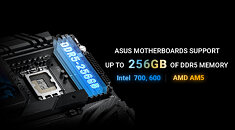TheLostSwede
News Editor
- Joined
- Nov 11, 2004
- Messages
- 18,934 (2.51/day)
- Location
- Sweden
| System Name | Overlord Mk MLI |
|---|---|
| Processor | AMD Ryzen 7 7800X3D |
| Motherboard | Gigabyte X670E Aorus Master |
| Cooling | Noctua NH-D15 SE with offsets |
| Memory | 32GB Team T-Create Expert DDR5 6000 MHz @ CL30-34-34-68 |
| Video Card(s) | Gainward GeForce RTX 4080 Phantom GS |
| Storage | 1TB Solidigm P44 Pro, 2 TB Corsair MP600 Pro, 2TB Kingston KC3000 |
| Display(s) | Acer XV272K LVbmiipruzx 4K@160Hz |
| Case | Fractal Design Torrent Compact |
| Audio Device(s) | Corsair Virtuoso SE |
| Power Supply | be quiet! Pure Power 12 M 850 W |
| Mouse | Logitech G502 Lightspeed |
| Keyboard | Corsair K70 Max |
| Software | Windows 10 Pro |
| Benchmark Scores | https://valid.x86.fr/yfsd9w |
ASUS today announced BIOS updates that enable support for up to 256 GB of memory on its Intel 700 and 600 series motherboards that use DDR5 modules. Such models with four DIMM slots can now support up to 256 GB of memory, while such models with two DIMM slots can now support up to 128 GB. These enhancements significantly improve multitasking potential, ensuring smooth and seamless computing. AMD AM5 motherboards from ASUS do not require a BIOS update to enable support for up to 256 GB of DDR5 memory modules.
The BIOS updates can be accessed on the ASUS support pages for the models listed below.



View at TechPowerUp Main Site | Source
The BIOS updates can be accessed on the ASUS support pages for the models listed below.



View at TechPowerUp Main Site | Source




